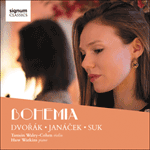
Welcome to Hyperion Records, a British classical label devoted to presenting high-quality recordings of music of all styles and from all periods from the twelfth century to the twenty-first.
Hyperion offers both CDs, and downloads in a number of formats. The site is also available in several languages.
Please use the dropdown buttons to set your preferred options, or use the checkbox to accept the defaults.

| Tamsin Waley-Cohen (violin), Huw Watkins (piano)» More |
The four movements work well in their new arrangement. In each of the movements, the solo string instrument leads off with the tune which, in the Allegro moderato and Allegro appassionato, turns out to be a fine example of Dvořák in lyrical vein, though with a tendency towards wistfulness. The vigorous second movement is angular and demonstrative, with an uncompromising folkish inflection that anticipates Janáček. The finale is an affecting and expressive Larghetto which brings the cycle to an attractive, if subdued, close.
from notes by Jan Smaczny © 1998
Les quatre mouvements fonctionnent bien dans leur nouvel arrangement. Dans chacun d’entre eux, l’instrument à cordes solo commence avec la mélodie qui se révèle, dans l’Allegro moderato et l’Allegro appassionato, un bel exemple de la veine lyrique de Dvořák, malgré une tendance à la nostalgie. Le vigoureux deuxième mouvement, anguleux et démonstratif, présente une ardente inflexion populaire qui anticipe Janáček. Le finale, un Larghetto touchant et expressif, amène le cycle à une conclusion attrayante, quoique sobre.
extrait des notes rédigées par Jan Smaczny © 1998
Français: Hypérion
Die vier Sätze passen gut in ihre neue Bearbeitung. In jedem einzelnen Satz führt der Solostreicher eine Melodie an, die sich—in Allegro moderato und Allegro appassionato—trotz eines Hanges zur Wehmut, als Musterbeispiel für Dvoráks schwärmerische Ader entpuppt. Der kraftvolle zweite Satz ist kantig und demonstrativ, und verfügt über einen kompromißlosen Einfluß der Volksmusik, der auf Janáček hindeutet. Beim Finale handelt es sich um ein rührendes und ausdrucksstarkes Larghetto, welches den Zyklus zu einem reizvollem, wenn auch gedämpftem, Abschluß bringt.
aus dem Begleittext von Jan Smaczny © 1998
Deutsch: Michael Stoffl
 Dvořák, Janáček & Suk: Bohemia - Violin Sonatas Dvořák, Janáček & Suk: Bohemia - Violin SonatasThe music of Dvořák, Suk and Janáček provides the musical backdrop to an album of bittersweet nostalgia for a time and a place now changed for ever.» More |

